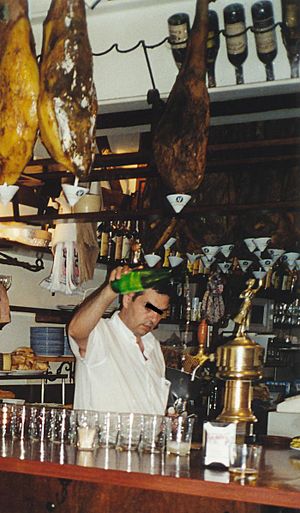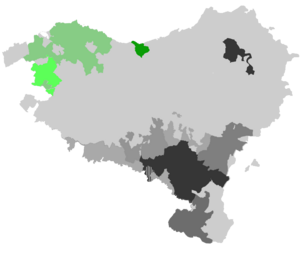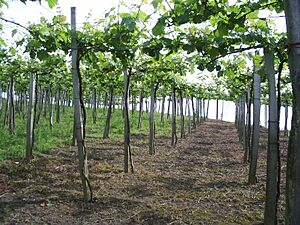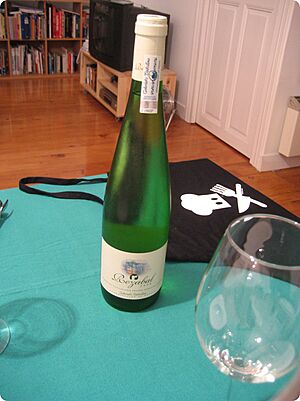Txakoli facts for kids
Txakoli or chacolí is a special type of white drink from the Basque Country in Spain. It's known for being a bit bubbly and having a fresh, slightly sour taste. It's also made in Cantabria and parts of Burgos in Spain, and a little bit in Chile.



Alavan Txakoli Biscayan Txakoli Getaria Txakoli
People often enjoy Txakoli as a refreshing drink before a meal. It goes especially well with small snacks called pintxos. It's usually poured from a height into tall glasses, which makes it slightly bubbly. It's best enjoyed within a year of being made. Most Txakoli is pale green, but you can also find red and pink (rosé) types.
There's even a museum dedicated to Txakoli, the Museo del Txakoli, in Leioa near Bilbao. It teaches you about its history and how it's made.
Contents
What's in a Name?
This drink is called txakolin in the Basque language. The word txakolina means "the txakolin." People have used this name since the mid-1700s. Sometimes, it was even used as a person's name.
In Spanish, it's called chacolí. This word also comes from the Basque txakolin. The first time vino chacolín (chacolí wine) was mentioned in Spanish was in a document from 1520. Sometimes, it's also called chacoli in French.
No one is completely sure where the word txakoli comes from. Many experts think it started in the Basque language. The ending -in is often found in Basque words for liquids. Some people have fun ideas about its origin, like it coming from "just enough for the home." Others think it might have come from French.
A Brief History
For a long time, until the 1980s, Txakoli was mostly a homemade drink. People in the Basque Country, Cantabria, and Valle de Mena made and drank it. It was almost forgotten by the mid-1800s.
However, things changed when some types of Txakoli in the Basque Country received special certification. This certification, called "denominación de origen" (DO), started in 1989. Since then, Txakoli has become much better known and more popular. Its quality has also improved a lot.
Different Types of Txakoli
Traditionally, Txakoli was made in very old, large oak barrels. But today, most Txakoli is made in modern stainless steel tanks. There are three main types of Txakoli that have the special DO certification.
Most Txakoli grapes grow in the Atlantic regions of the Basque Country. These areas get a lot of rain, usually between 1000 and 1600 millimeters each year. The average temperatures are between 7.5°C and 18.7°C. Sometimes, it can even get frosty.
Getaria Txakoli
This type is called Getariako Txakolina in Basque. It comes from a small area in Gipuzkoa. The main towns where it's made are Getaria, Zarautz, and Aia. This Txakoli is very pale yellow to green. It was the first type to get the DO certification in 1989.
The area where these grapes are grown has grown a lot since then. Farmers now produce about 900,000 liters (237,755 US gallons) of this Txakoli every year. The grapes are often grown on slopes that face southeast. This helps protect the vines from the strong Atlantic weather.
Unlike other grape varieties, these grapes are grown using a special method called the trellis system. In this system, the vines are grown higher off the ground. Their leaves form a continuous cover, which helps create a better growing environment. The main white grape used is Hondarribi Zuria. For red Txakoli, the Hondarribi Beltza grape is used.
Recently, other towns in Gipuzkoa have also started making Txakoli under this certification. These include Orio, Zumaia, Arrasate, Eibar, Mutriku, Deba, Zestoa, Hondarribia, Villabona, Urnieta, Oñati, Beizama, Zerain, and Olaberria.
Biscay Txakoli
This type is known as Bizkaiko Txakolina in Basque. It's made in most parts of Biscay, except for the very western end. This was the second Txakoli to get the DO certification in 1994.
About 150 hectares (370 acres) of land are used to grow these grapes. This happens in 85 villages and towns across Biscay. They produce around 700,000 liters (184,920 US gallons) of Txakoli each year. People have been making wine in this region since the 700s!
The quality of this Txakoli can be different because the weather conditions vary. Both white and red grapes are used. The white grapes are Hondarribi Zuria and Folle blanche (called Munemahatsa here). The red grape is Hondarribi Beltza.
In the past, another light red grape called Oilar Begi (which means "chicken eye") was also used. This grape almost disappeared, but it's slowly making a comeback.
Alava Txakoli
This type is called Arabako Txakolina in Basque. It comes from the far northwestern part of Álava. It's the newest of the three DO Txakoli types, getting its certification in 2001. This Txakoli is yellowish, very sour, and a bit bubbly.
It's grown on about 55 hectares (136 acres) of land. The main towns involved are Aiara, Amurrio, Artziniega, Laudio, and Okondo. Wine-making has a long history here, going back to 760 AD. In the late 1800s, over 500 hectares (1,235 acres) were used for grapes. This dropped to only 5 hectares (12 acres) in the late 1900s before its recent return.
The most common grape for this Txakoli is Hondarribi Zuria. But other grapes are also allowed, such as Bordeleza Zuria (Folle Blanche), Izkiriota Ttipia (Petit Manseng), Izkiriota (Gros Manseng), and Courbu.
Cantabria Chacolí
Chacolí was also traditionally made in the region of Cantabria until the late 1800s. A lot of this drink was made and sent out from the 1200s to the 1800s. Villages like Colindres, Arnuero, Meruelo, Argoños, and Noja were important areas for growing grapes and making chacolí.
Even in the mid-1900s, Cantabria made more wine than the Basque provinces. Today, Cantabria has two special wine areas (called "geographical indications"). These were created in 2004 and 2005. One of them, the Costa de Cantabria wine area, includes the region where chacolí was traditionally made. Chacolí is still made in Cantabria, but only a very small amount.
Burgos Chacolí
Chacolí is also still made in the Valle de Mena in the province of Burgos. This area is part of the Castilla y León wine area, created in 2005. People there are working to get their own DO certification for their chacolí.
See also
 In Spanish: Chacolí para niños
In Spanish: Chacolí para niños



